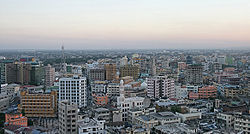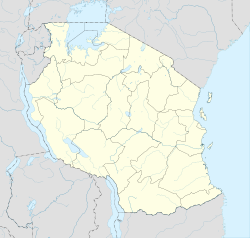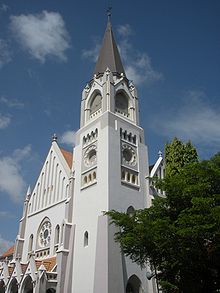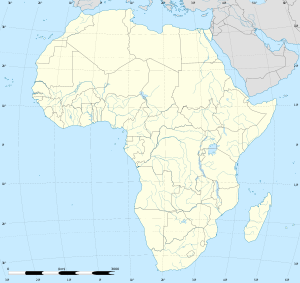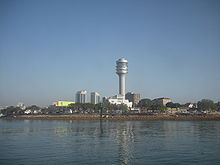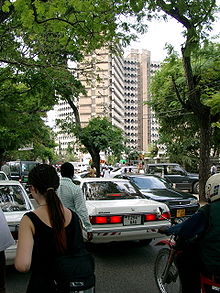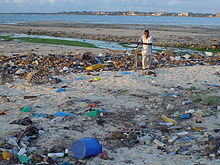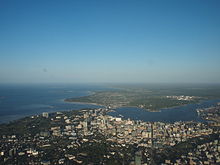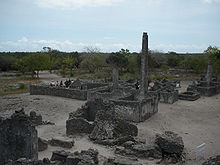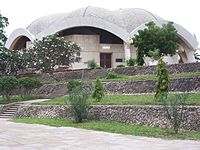- Dar es Salaam
-
This article is about the city. For the region, see Dar es Salaam (region). For the 2000 Chadian film, see Daresalam. For the 'Divisions of the world in Islam', see Divisions of the world in Islam.
Dar es Salaam
Mzizima
Dar— City — Dar es Salaam City skyline Location of Dar es Salaam in Tanzania Coordinates: 6°48′S 39°17′E / 6.8°S 39.283°ECoordinates: 6°48′S 39°17′E / 6.8°S 39.283°E Country Tanzania Districts Government - Mayor Dr Didas Massaburi AreaRegion/Province - City 1,590.5 km2 (614.1 sq mi) - Water 0 km2 (0 sq mi) Population (2002) - Metro 2,497,940 Time zone GMT +3 Dar es Salaam (Arabic: دار السلام Dār as-Salām, "harbour of peace"), formerly Mzizima, is the largest city in Tanzania. It is also the country's richest city and a regionally important economic centre. Dar es Salaam is actually an administrative province within Tanzania, and consists of three local government areas or administrative districts: Kinondoni to the north, Ilala in the centre of the region, and Temeke to the south. The Dar es Salaam Region had a population of 2,497,940 as of the official 2002 census. Though Dar es Salaam lost its official status as capital city to Dodoma in 1974 (a move which was not complete until 1996), it remains the centre of the permanent central government bureaucracy and continues to serve as the capital for the surrounding Dar es Salaam Region.
Contents
History
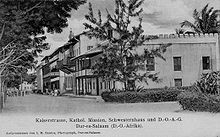 Kaiserstraße road, in Dar es Salaam, German East Africa, c. 1905
Kaiserstraße road, in Dar es Salaam, German East Africa, c. 1905
In the 19th century Mzizima (Swahili for "healthy town") was a coastal fishing village on the periphery of Indian Ocean trade routes.[1][2] In 1865 or 1866 Sultan Majid bin Said of Zanzibar began building a new city very close to Mzizima.[2] He named it from an Arabic phrase bandar as-salām meaning harbour of Peace.[2] A popular but erroneous translation is "haven of peace" resulting from a mixup of the Arabic words "dar" (house) and "bandar" (harbour). Dar es Salaam fell into decline after Majid's death in 1870, but was revived in 1887, when the German East Africa Company established a station there. The town's growth was facilitated by its role as the administrative and commercial centre of German East Africa and industrial expansion resulting from the construction of the Central Railway Line in the early 1900s.
German East Africa was captured by the British during World War I and from then on was referred to as Tanganyika. Dar es Salaam was retained as the territory's administrative and commercial centre. Under British indirect rule, separate European (e.g. Oyster Bay) and African (e.g. Kariakoo and Ilala) areas developed at a distance from the city centre. The town's population also included a large number of South Asians. After World War II, Dar es Salaam experienced a period of rapid growth.
Political developments, including the formation and growth of the Tanganyika African National Union (TANU), led to Tanganyika attaining independence from colonial rule in December 1961. Dar es Salaam continued to serve as its capital, also when in 1964 Tanganyika and Zanzibar merged to form Tanzania. However, in 1973 provisions were made to relocate the capital to Dodoma, a more centrally located city in Tanzania's interior. The relocation process has not yet been completed, and Dar es Salaam remains Tanzania's primary city.
Geography
Dar es Salaam is located at 6°48' South, 39°17' East (−6.8000, 39.2833).[3] The city is situated on a massive natural harbour on the Eastern Indian Ocean coast of Africa, with sandy beaches in some areas.
Administratively, Dar es Salaam is broken into three districts: Ilala, Kinondoni, and Temeke.
Climate
Being situated so close to the equator and the warm Indian ocean, the city experiences generally tropical climatic conditions, typified by hot and humid weather throughout much of the year. Dar es Salaam features a tropical wet and dry climate, with two different rainy seasons. Annual rainfall is approximately 1,100 mm (43 in) and in a normal year there are two distinct rainy seasons: "the long rains", which fall during April and May, and "the short rains", which fall during October and November.
Climate data for Dar es Salaam Month Jan Feb Mar Apr May Jun Jul Aug Sep Oct Nov Dec Year Average high °C (°F) 31
(88)31
(88)31
(88)30
(86)29
(84)29
(84)28
(82)28
(82)28
(82)29
(84)30
(86)31
(88)29.6
(85.2)Average low °C (°F) 25
(77)25
(77)24
(75)23
(73)22
(72)20
(68)19
(66)19
(66)19
(66)21
(70)22
(72)24
(75)21.9
(71.5)Precipitation mm (inches) 66
(2.6)66
(2.6)130
(5.12)290
(11.42)188
(7.4)33
(1.3)31
(1.22)25
(0.98)31
(1.22)41
(1.61)74
(2.91)91
(3.58)1,066
(41.97)Avg. rainy days 8 6 12 19 15 6 6 7 7 7 9 11 113 Sunshine hours 248 196 217 150 217 210 217 279 270 279 240 248 2,771 Source: BBC Weather [4] Population
Dar es Salaam is the largest city in Tanzania with 2.8 million people. With a population rate increase of 4.39% annually the city has become the 3rd fastest growing in Africa (9th fastest in the world) after Bamako and Lagos, respectively. The metro population is expected to reach 5.12 million by 2020.[5]
- 1925: 30,000
- 1948: 69,000
- 1957: 129,000
- 1972: 396,000
- 2005: 2,456,100
- 2010: 3,000,000 (rounded estimate)
Economy and infrastructure
Dar es Salaam is Tanzania's most important city for both business and government. The city contains unusually high concentrations of trade and other services and manufacturing compared to other parts of Tanzania, which has about 80 percent of its population in rural areas. For example, about one half of Tanzania's manufacturing employment is located in the city despite the fact that Dar holds only ten percent of Tanzania's population. Located on a natural harbour on the Indian Ocean, it is the hub of the Tanzanian transportation system as all of the country's main railways and several highways originate in or near the city. Its status as an administrative and trade centre has put Dar es Salaam in position to benefit disproportionately from Tanzania's high growth rate since the year 2000 so that by now its poverty rates are much lower than the rest of the country. The Benjamin William Mkapa Pension Tower with more than 21 stories is the tallest building in the city and the country.[6] One important thing to keep in mind about Dar es Salaam and other Tanzanian cities is that in the past few years there has been a major construction boom, despite the fact that there is a much higher demand for electricity, which is rationed around the country. In the past 10 years, Dar es Salaam has literally had a face-lift, however the major infrastructural problems still remain. Among those problems are an outdated transport infrastructure and power rationing, which continues to badly affect the Tanzanian economy.
Air Tanzania, the national airline, has its head office in Dar es Salaam.[7]
Transportation
The Julius Nyerere International Airport is the principal airport serving the country, named after the country's first President. The TAZARA Railway connects Dar es Salaam to the neighbouring country of Zambia. The Central Line (Railway) runs west from Dar es Salaam to Kigoma on Lake Tanganyika via Dodoma.
Culture
Downtown Dar es Salaam includes many small businesses, many of which are run by traders and proprietors whose families originated from the Middle East and Indian sub-continent — areas of the world with which the settlements of the Tanzanian coast have had long-standing trading relations. During the daytime the heavy weight of traffic, office workers, busy merchants, street vendors and restaurateurs of the area lend it a frenetic and slightly claustrophobic air. However, after nightfall the area is relatively quiet as much of the city's nightlife is located in more residential districts away from the city's mainly commercial centre.
The sprawling suburbs furthest from the city centre are generally populated by Tanzanians of African descent, with the exception of Oyster Bay, where there is a large population of foreign expatriates. Although there is no racial hostility, the various ethnic communities of Dar es Salaam do not tend to mix heavily. The edges of Dar es Salaam are spreading rapidly, severely taxing the transportation network (which aside from ferries, lacks any kind of mass transit facilities)[8] and raising the prospect of future urban overcrowding.
Food
Due in part to the growth of the expatriate community and the increasing importance of tourism, the number of international restaurants has risen very rapidly over recent years. The city now offers a rich and internationalized diversity of cuisine, ranging from traditional Tanzanian Barbecue style options such as Nyama Choma (Roasted Meat - served with Rice or Ugali) and Mishkaki (Shish Kebab - usually barbecued and served with Salt, Hot Peppers, Chapati, Fries, and Rice on the side), and the long-established traditional Indian and Zanzibari cuisine, to options from all corners of the globe including Chinese, Thai, Turkish, Italian, and Japanese food. Restaurants like City Garden, Addis in Dar, and Best Bite are only a few of the most popular restaurants located in Dar es Salaam. Even fast food restaurants like Steers and Subway now have prominent place in the restaurant sector of Dar es Salaam. People who prefer neither fast food or traditional restaurants buy their food from street vendors, who usually sell good food for very affordable prices. Primary and Secondary school students are usually more likely to buy food from street vendors than other age demographics.
Entertainment
There is also a lively music scene in Dar es Salaam which is divided between several styles. The longest standing segment is live dance bands such as Kilimanjaro, Twanga Pepeta and FM Academia. Taarab which was traditionally strong in Zanzibar has also found a niche but remains small compared both to dance music and "Bongo Flava", a broad category that represents the Tanzanian take on Hip Hop and R&B, which has quickly become the most popular locally produced music. This type of music is especially strong among the youth and it seems that its pull is reducing the interest in performing and hearing dance music. Songs by artists such as Ferooz name check Dar districts such as Sinza. Traditional music, which locally is used to refer to tribal music is still performed but typically only on family oriented occasions such as weddings.
Much like the popular music of other major cities Dar es Salaam's hip music of the day Bongo Flava is a cultural escape for youths that speaks to topics of everyday life such as "HIV/AIDS, scraping a life together, the difficulty of meeting basic needs, class and wealth barriers, holding your head high despite everything." [9]
This Rap scene has been present and growing for the past ten years as City life has drawn much of the youth in surrounding areas have made the trek into a more urban lifestyle in search of a new better beginning.[10]
In the 1970s, the Ministry of National Youth Culture aimed to create a national culture, which stressed the importance of music.Dar es Salaam became the new music center in Tanzania, with the local radio exposing new bands and dominating the music and cultural scene. With this ujamaa, or family, mentality governing culture and music a unified people’s culture was created. Dar es Salaam became a center of city crime, gangs, and violence, which lead to the rise of hip hop music.[11] Throughout the years, the radio in Dar es Salaam has played a major role in the dissemination of music because many people don’t have televisions and cassettes are used over CDs. In addition, creating music in Dar es Salaam involves significant dedication because artists receive little pay due to inadequate[neutrality is disputed] copyright laws[citation needed].
Tourism
A variety of museums, including the National Museum, the Village Museum and the Botanical Garden are all very close by.
Within an hour's drive north is Bagamoyo, which is home to the Kaole ruins. There are beaches on the Msasani peninsula north of Dar es Salaam and in Kigamboni to the south where residents and tourists alike frequently visit. Trips to the nearby islands of the Dar es Salaam Marine Reserve are a popular daytrip from the city and a favourite spot for snorkeling, swimming and sunbathing. In addition to that, Bongoyo Island is just a boat ride away from Msasani Slipway. Although the variety and population of coral and fish species are not as numerous as other sites on Zanzibar, Pemba, and Mafia Island, the Bongoyo Island Marine Reserve is well worth a visit and is a great way to spend a day out and see the coast. The National Stadium hosts Dar es Salaam's Young Africans Football Club, Simba Football Club, other Tanzanian football clubs, and many other international matches. Zanzibar consists of beautiful spice tours, unique red monkeys and the must see "Stone Town". Safari's are also a must in Dar es Salaam with Selous, Serengeti National Park, Lake Manyara National Park and one of the wonders of the world, the Ngorongoro Crater not forgetting Mount Kilimanjaro.
Newspapers
Dar has a considerable number of newspapers available, particularly obviously from sellers prowling through stationary traffic at road intersections. English-language ones, with online presences, include "The Citizen" and "The Guardian". There are several times this number of Swahili-language ones available (this is only a crude estimate from observations in late 2011). Other sources | disagree on both the number of newspapers and their language composition. Given that Internet access is still relatively expensive, it is likely that the online presence of Swahili language newspapers (and other culture information) is highly biased against.
Internet Access
Recent (2009) landfall of a trans-Indian Ocean backbone cable has, in theory, made Internet access much more readily available in Dar in particular and in East Africa in general. Certainly it has had an effect, but roll-out to end-users is slow, partly because of spotty telephone line coverage, partly due to the substantial prices and long contracts demanded for purchase of bandwidth for small ISPs (citation : discussion with local IT people unwilling to make the investment, though seriously considering the market). Mobile-telephone access to the Internet ("3G") is heavily advertised in the city (late 2011), though still relatively expensive.
Internet cafes are fairly well distributed in the city centre, with typical prices advertised on hoardings at around 1TZS per second. (In practical terms this approximates to "one beer per hour", which is comparable to Internet cafes in Britain at this time (2011).)
The expressed aim of the SEACOM cable is to enable East Africa to develop economically through increased online trading. This process is continuing at the time of writing (2011), with mixed results.
Globalization
Globalization has affected many of the cultural expressions in Dar es Salaam, in particular, hip hop music and culture. The hip hop scene in Dar es Salaam articulates a blending of local cultural struggles and the indigenization of global influences.[11] Hip hop music and culture arrived in Tanzania, taking its cues from various African American styling. Birgit Quade highlights Tanzanian hip hop's connection to US culture when she writes: "What makes hip-hop a global phenomenon is that it draws upon style, music, and look that is not restricted to any local region or language... In the mid-1980s, young people who saw the first hip-hop films and videos coming from America and started break-dancing and rapping." [12] The adaptations of language, fashion, style, and content within Tanzanian hip hop culture have evolved gradually. The result of this evolution has created a localized form of hip hop, often showcasing native dialectic lyrical performances and traditional garbs. While hip hop in Dar es Salaam is a clear reflection of Tanzanian localized struggle and culture, it also engages in and compromises with aspects of Western culture.
According to Eric Achakeng of the University of Adelaide, Globalization has raised some troubling concerns for the developing world, including Africa. One such concern is its impact on urbanization and the ramifications that go with it. Cities are traditionally engines of social modernization and economic growth and at the same time the theatres in which globalization stages its actions. For Africa this has meant fueling the already unprecedented urban growth phenomenon and increasing the challenges that go with it. One key challenge is the management of municipal solid waste. Dar es Salaam, a city which is projected to have over 5 million inhabitants within the next decade, continues to be the one city in Tanzania which villagers flock to for better opportunities, while on the other hand more Westerners and Asians are settling in Dar es Salaam. This surge of foreigners from the West has put more pressure on Dar es Salaam officials to implement laws which would better accommodate the growing diverse population of Dar es Salaam and its suburbs.
Safety
Safety has become a noticeable feature in Dar es Salaam and many other Tanzanian cities. Dar es Salaam is one of the safest large cities in East Africa. Homicides are rare, even in the poor areas of Dar es Salaam. Chain snatching is relatively common in the kariakoo area. Although pick pocketers frequent the City Centre and Dala Dalas and prey especially on foreigners, there are rarely reports of violent crimes. Unfortunately, the relative poverty in Dar es Salaam drives some people to steal from small store-owners. These crimes are usually taken into the hands of individual citizens who usually feel that street justice is the only way for the thief to learn his or her lesson. Street justice can be fatal to the petty thief. Sometimes innocent people are beaten and occasionally killed for crimes that they did not commit. The distrust in the police and their corrupt ways is one of the reasons why citizens take matters into their own hands. One might argue that the fear of stealing for most Tanzanians is morally positive, while others might argue that the accused deserves a fair trial under the law. Because of this and many other factors, Dar es Salaam has become an exceptional city when it comes to safety, whether it be fear or simply a culture of peace.
Education
Nkrumah Hall at the University of Dar es Salaam
Dar es Salaam is also the educational centre of Tanzania. The city is home to many Educational Institutions.
Universities
- The University of Dar es Salaam is the oldest and biggest public university in Tanzania. It is situated on the western side of the city of Dar es salaam, occupying 1,625 acres (6.58 km2) on the observation hill, 13 kilometers from the city centre. The university is home to approximately 16,400 undergraduates and approximately 2,700 postgraduates.[13]
- Ardhi University has some 2613 registered students (2457 Undergraduates and 156 Postgraduates) as of year 2010/2011. The Institute offers two-year diploma programmes in the fields of Land Surveying and Land Management and Valuation. Moreover, a three-year Diploma program in Urban and Rural Planning was introduced.[14]
- Muhimbili University of Health and Allied Sciences (MUHAS) has two campuses; Muhimbili Campus and Mloganzila Campus. Muhimbili Campus is situated in Ilala Municipality, in Upanga along United Nations Road. Mloganzila Campus is still new and in the process of development and it occupies 3,800 acres (15 km2) and is located 3 km off Dar es Salaam-Morogoro highway, 25 km from Dar es Salaam.[15]
- The Open University of Tanzania is a fully fledged and accredited public Institution of Higher learning, mandated to conduct academic programmes leading to Certificates, Diplomas, Undergraduate and Postgraduate qualifications. In the 15 years of existence, the OUT has enrolled students from Malawi, Uganda, Kenya, Namibia, Hungary, Burundi, Libya, Ethiopia, Rwanda, Saudi Arabia, Lesotho, Botswana and most of the United Republic of Tanzania. As of 2008, the total enrollment at OUT was at 44,099, the majority of which Tanzanian.[16]
- The Hubert Kairuki Memorial University (HKMU) is a private institution located on plot No. 322 Regent Estate in the Mikocheni area, some 7-km from the Dar es Salaam City centre, off Ali Hassan Mwinyi and Old Bagamoyo roads.[17]
- The International Medical and Technological University (IMTU) is a privately owned institute of higher education institution operating in Dar es Salaam.[18]
- Kampala International University- began operations in January 2009 operating from Quality Plaza along Pugu road.Currently, the University Centre is situated on a 60 acres (240,000 m2) of land, at Gongo la Mboto area in Ilala District, 7 km from Mwalimu Julius Nyerere International Airport along Pugu road.[19]
Other institutes of higher education include:
- The Institute of Financial Management (IFM)
- Dar es Salaam Institute of Technology (DIT)
- College of Business Education (CBE)
- The Institute of Social Works
- College of Public Service
- The Mwalimu Nyerere Memorial Academy
- The National College of Tourism
- Dar es Salaam Maritime Institute
- Saint Joseph College of Engineering and Technology
Schools
Dar es Salaam also boasts some of the finest schools in Tanzania, most of which are private. The following are schools that provide secondary education, O Levels and A Levels in Tanzania, according to the National Examination Council Of Tanzania (NECTA) syllabus.
Private secondary education schools include
- St. Anthony's Secondary School-Mbagala
- Loyola High School
- Al Muntazir Islamic Seminary
- The Ali Hassan Mwinyi Elite School
- Agakhan Mzizima Secondary School
- Shaaban Robert Secondary School
- Hindu Mandal Schools
- Kenton High Schools
- Saint Mary's Schools
- Alpha High School
Some of the International Schools in Dar es Salaam are the
- International School of Tanganyika (IST)
- Haven of Peace Academy (HOPAC)
- Dar es Salaam International Academy (DIA)
- Dar es Salaam International School (DIS)
- Laureate International School
- Esacs International Academy
- Indian School Dar es Salaam (India's CBSE Affiliated School)(http://www.isdtz.org/about_us.htm)
- Academic International School
Some of the Leading Government Schools, which are also the largest in the city include
- Jangwani Girls Secondary School
- Azania Boys Secondary School
- Tambaza High School
- Forodhani Secondary School
- Kibasila High School
- Zanaki Girls High School
- Kisutu Girls Secondary School (which offers only O' level)
- Benjamin William Mkapa High School (former City High School)
- Pugu High School (Boys Boarding School outside the city)
Suburbs
Dar es Salaam is divided into three districts: Ilala, Kinondoni and Temeke. All three are governed as municipal councils, and so all of the city's suburbs or wards are affiliated with them.
Kinondoni
Kinondoni is the most populated amongst the districts, with half of the city's population residing within it. It is also home to many of the high-income suburbs. These include:
- Masaki, Oysterbay and Ada Estate are the posh suburbs located along the central beach. During the Colonial Era, they were the major European suburbs of the city. Now, similarly, many diplomats and expatriots reside in these areas. Oysterbay Beach, also known as Coco Beach, is the only white sandy beach in Kinondoni and is the most famous in the area. Many newly built luxury apartments line the waterfront, accommodating the rapid growth of foreigners, mostly Europeans and Asians.
- Mikocheni and Regent Estate are also suburbs within the district. According to the 2002 census, the wards have a total population of 27,283.[20] Mikocheni is the home of some major political figures including the first president of Tanzania, Julius K. Nyerere.
- Msasani is a peninsula to the northeast of the city center. It's home to many of the expatriates from Britain and other western countries that live in Dar es Salaam. Msasani contains a mixture of traditional shops and western-oriented resorts and stores.
- Mbezi Beach is the beachfront suburb located along the northern Dar es Salaam Beach. It is noted for its beautiful beaches with several tourist hotels, and also as the place of residence of many people of high social status and some politicians.
- Sinza, Kijitonyama, Magomeni, Kinondoni and Mwenge are more ethnically mixed than the areas mentioned above. These were perhaps the earliest African suburbs to be occupied. The wards also have the most prosperous business climate outside of the central business district, with many shops, bars, restaurants and inexpensive hotels located here.
- Kimara and Mbezi Louis are hilly, mostly middle and upper class, suburbs far from the city. Due to the distance from the city center, it is quieter, with cooler weather.
- Manzese, Tandale, Mwananyamala-Kisiwani and Kigogo are considered low-income neighborhoods characterized by poor settlement planning, low quality housing and social services.
Ilala
Ilala is the administrative district of the city where almost all government offices and ministries are housed. The Central Business District (locally called "Posta") is also located in this district. Furthermore, it is the transportation hub of the city, as the Julius Nyerere International Airport, Central Railway Station and Tazara Railway Station are all within the district boundaries. The residential areas are mainly middle to high-income, and some of these are:
- Upanga & Kisutu have the highest concentration of Asian communities within Dar es Salaam, with many residents of Indian and Arabian descent. These areas are also famous for the many colonial houses and mansions built in Indian, Arabic and European styles.
- Kariakoo is the shopping district of the city, perhaps the busiest and largest in East Africa. Many shops, bazaars and merchants dot the streets, selling a variety of products, from foodstuffs to hardware materials. The Kariakoo Market, which is the largest, contains the only underground section of the city. It is the major supply point of the food consumed by all the residents of Dar es Salaam.
- Tabata, Segerea and Ukonga located a bit far from the city center, these suburbs are growing to become among the busiest in terms of business and entertainment. This has caused serious traffic congestion, which is said to be the worst in all of Dar es Salaam.
- Ilala this is also among the middle income suburbs, very near to the city center, marked by the Askari Monument.
Temeke
Temeke is the industrial district of the city, where the main manufacturing centers (with both heavy and light industries) are located. The Dar es Salaam Port, which is the largest in the country, is also found here. Temeke is believed to have the largest concentration of low-income residents due to industry. Also, many port officials, military and police officers live here.
- Kurasini located right on the Dar es Salaam Harbour, is the home of the Dar es Salaam Port, The Police College, Mgulani Police Barracks and the Dar es Salaam International Trade Fair Grounds. Thus, the main residents are police officers and port officials.
- Chang'ombe, this suburb is one of the only higher income areas in Temeke. It has maintained this status due to occupation by African high colonial officers and some industry owners from the colonial era. Chang'ombe is also the home of the Dar es Salaam University College of Education, The National Stadium and Uhuru Stadium.
- Temeke, Mtoni and Tandika are middle to low-income suburbs.
- Mbagala and Kijichi also are middle to low-income suburbs where Mbagala is the Largest suburb in the whole district, and is also considered a slum.
- Kigamboni (South Beach) is a beach front suburb with very beautiful, sandy beaches. Few people live here due to recent gentrification, where real-estate developers have bought out many of the properties and are trying to transform the area with high-quality, luxury residences. Some of the most famous beach parks and resorts are also in Kigamboni.
Sports
Dar es Salaam is the sports center of Tanzania. Dar es Salaam hosts the largest stadium in East and Central Africa (National Stadium) which can accommodate up to 60,000 people. The city is the home of the most famous and rival Soccer clubs, The Simba Sports Club (Simba) and Young Africans Sports Club (Yanga). Apart from the National Stadium, Dar es salaam is home to the Uhuru Stadium (used mainly for local tournaments and political gatherings), Karume Memorial Stadium (the home of Tanzania Football Federation /TFF/), the Gymkhana Golf Courses (between the city center and the shores of the Indian Ocean) and also has Tennis courts, Squash courts and a Fitness club. Outside the metropolitan districts there is the Lugalo Military Golf Course (located in the Lugalo Military Barracks).
Notable people
- Hasheem Thabeet – Houston Rockets basketball center
- Millen Magese- Ford model model for based in New York, comes from Dar es salaam
- Tausi Likolola- model, book writer, comes from Dar es salaam
- Marin Hinkle - actress, Two and a Half Men TV Show
- Nairn McEwan, Scotland rugby union player and second national coach was born in Dar es Salaam.[21]
- Roald Dahl - famous writer, lived and fought in Dar es Salaam (World War II) for five years
- David Adjaye - Architect, London-based was born in Dar es Salaam in 1966
Partner cities
References
- ^ United Nations Human Settlements Programme (2009). The State of African Cities 2008. UN-HABITAT. pp. 130. ISBN 9211320151. http://books.google.co.uk/books?id=UR0fckrquD8C&pg=PA130.
- ^ a b c Brennan, James R.; Burton, Andrew (2007). "The Emerging Metropolis: A history of Dar es Salaam, circa 1862–2000". Dar es Salaam: histories from an emerging African metropolis. African Books Collective. pp. 13. ISBN 9987449700. http://books.google.co.uk/books?id=-54DSfk0ZMgC&pg=PA13.
- ^ NGA: Country Files, NGA.mil
- ^ http://news.bbc.co.uk/weather/forecast/120?
- ^ City Mayors: World's fastest growing urban areas (1)
- ^ List of tallest buildings in Dar es Salaam
- ^ "The website is currently under maintenance following our ai." Air Tanzania. Retrieved on 2 March 2010.
- ^ "A Taxi Ride to the Client Office in Dar es Salaam, Tanzania". A Taxi Ride to the Client Office in Dar es Salaam, Tanzania. http://drshem.com/2011/05/30/a-taxi-ride-to-the-client-office-in-dar-es-salaam-tanzania/. Retrieved 2011-06-11.
- ^ Bongo Flava: Swahili Rap from Tanzania
- ^ Africanhiphop.com presents: Hali Halisi - the Real Situation
- ^ a b Lemelle, Sidney J. (2006). "Ni wapi Tunakwenda': Hip Hop Culture and the Children of Arusha". In Basu, Dipannita; Lemelle, Sidney J.. The Vinyl Ain't Final: Hip Hop and the Globalization of Black Popular Culture. London; Ann Arbor, MI: Pluto Press. pp. 230–254. ISBN 0745319408.
- ^ Top of the Hip Hops
Bongo Flava and more in Dar es Salaam, 2004 - ^ http://www.udsm.ac.tz/about_us/index.php
- ^ Ardhi University www.aru.ac.tz
- ^ http://www.muhas.ac.tz/index.php?option=com_content&task=view&id=16&Itemid=30
- ^ http://www.out.ac.tz/index.php/about-out.html
- ^ http://www.hkmu.ac.tz/index.php/hkmu/about/category/about_HKMU/
- ^ http://www.imtu.edu/imtu.htm
- ^ http://www.kiu.ac.tz/mission.html
- ^ "2002 Population and Housing Census General Report". Government of Tanzania. http://www.tanzania.go.tz/census/census/districts/kinondoni.htm. Retrieved 2008-08-21.[dead link]
- ^ http://www.scrum.com/scotland/rugby/player/7713.html
External links
 Media related to Dar es Salaam at Wikimedia CommonsCategories:
Media related to Dar es Salaam at Wikimedia CommonsCategories:- Dar es Salaam
- Cities in Tanzania
- Regional capitals in Tanzania
- Dar es Salaam Region
- Former national capitals
- Port cities in Tanzania
- Ports and harbours of the Indian Ocean
- German East Africa
- Populated coastal places in Tanzania
Wikimedia Foundation. 2010.

